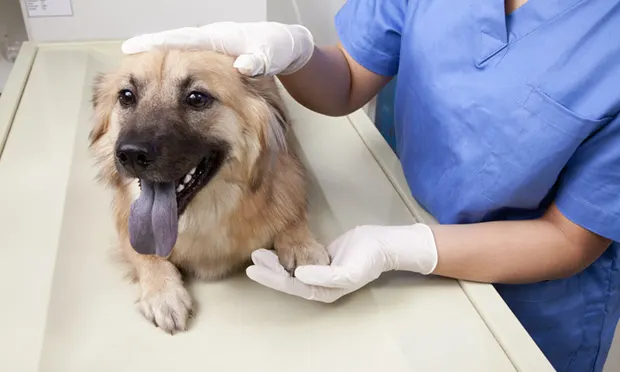Canine Anxiety

What are the best approaches to consider when faced with an anxious canine patient?
Anxious and fearful behaviors are common in canine patients and often manifest as separation anxiety, storm and noise phobia, or aggression (directed at humans and/or other dogs). Short-term stress response is healthy and necessary, allowing dogs to be alert and take action (eg, retreating from a stranger, scary sound, another dog). However, when the response is prolonged (eg, a season-long storm phobia or panic every time an owner leaves), physical and emotional pathologic conditions may ensue, potentially shortening the dog’s lifespan.1
Related Article: Addressing Any Behavior Problem
Manifestations of chronic stress include immunosuppressive effects (subjecting patients to increased likelihood of recurrent infections), compulsions, and altered blood flow to organs (resulting in susceptibility to further ailments [eg, gastric ulcers]).2,3
RECOGNIZING ANXIETY
It is incumbent on the clinician to determine what the patient is trying to communicate by watching the dog’s behavior. Anxiety and/or fear are presumed to exist when the animal exhibits specific behaviors (see Table: Signs of Canine Anxiety & Fear).4,5
TREATMENT
Regardless of the anxiety-rooted problem, behavior modification via avoidance, desensitization, counter-conditioning, and response substitution is the primary treatment approach.
Related Article: Effective Client Counseling for Behavior Issues
Avoidance
Avoidance of an anxiety-provoking trigger is important, especially in the early stages of treatment, but is often difficult to achieve. For example, avoiding storms if a phobic patient lives in a storm-prone area or avoiding other dogs if a dog-reactive patient lives in a multifamily complex (eg, apartment, condominium) that necessitates eliminating in places where other dogs may be present can be impossible.
Discussing options with individual caretakers is important. For a storm-phobic dog, decreasing the visual and auditory stimuli may help: closing the blinds, placing the dog in a room with no windows, using ear plugs, having background noise (eg, fan, music). For a dog-reactive dog, taking the dog outdoors at quiet times of the day and/or providing pads, artificial turf, or a patch of sod indoors might be helpful.
These solutions need not be long-term but can provide clients and patients with a break from daily anxiety-provoking stimuli.
Desensitization
Desensitization involves minimizing the intensity of an anxiety-eliciting stimulus to a level that the fear response is not incited (eg, reducing volume, increasing distance, changing environment).6 For example, desensitization for a dog that fears strangers begins with the stranger being close enough that the dog knows the individual is there, but far enough away so the dog does not hide behind its owner with ears back and tail down. The stimulus is slowly increased by decreasing the distance between the dog and stranger, ideally with the dog approaching the stranger. A dog approached by a stranger is more likely to feel trapped and anxious, whereas allowing the dog to approach the stranger provides a comfortable opportunity to retreat, if necessary. With desensitization, the dog eventually learns to be comfortable in the presence of a stranger.

Counterconditioning
Counterconditioning involves consistent and repeated pairing of a stimulus that evokes an unpleasant response with a positive stimulus until a positive association is made.6 Counterconditioning can be coupled with desensitization when a dog is relaxed but can also be attempted when the patient is still somewhat anxious. In either case, the goal is for the dog to have a positive experience (eg, storm-phobic dog associating a treat with thunder, dog-reactive patient associating a tennis ball with an approaching dog).
Response Substitution
Similar to counterconditioning, response substitution involves replacing an undesirable response with a desirable one.6 For example, instead of displaying behavior XY (eg, hear thunder, hide under the desk), the behavior becomes XQ (eg, hear thunder, look for a treat).
The primary challenge with counterconditioning and response substitution is that some owners perceive the dog as being rewarded for undesirable behavior. It is important to explain that the dog is learning a different response; the patient will not hide and shake if it is eating a treat or bark and lunge if it focuses on a tennis ball.
MEDICAL THERAPY
Anxiolytic medications can be useful in treating fear-based behaviors. The short-term, as-needed use of benzodiazepine (eg, alprazolam, diazepam) can reduce anxiety while increasing appetite, potentially making counterconditioning and response substitution more successful.
For dogs that are generally anxious (ie, in a number of situations and/or during most of the day), a maintenance medication (eg, fluoxetine, clomipramine, buspirone) may be indicated.7 Typically, these medications can be used alone or combined with a rapid, short-acting medication, such as benzodiazepine.8
For dogs that are more contextually anxious or fearful (eg, during storms, fireworks, family [children] visits), short-acting benzodiazepines could be used alone. Trazodone, an antidepressant believed to inhibit serotonin uptake, also can be effective alone or in combination with a selective serotonin reuptake inhibitor (SSRI), tricyclic antidepressant (TCA), or benzodiazepine.9
Related Article: Medical Management of Behavioral Problems
ALTERNATIVE THERAPIES
Dog-appeasing pheromone (Adaptil) is available as a diffuser, collar, and spray and can be beneficial when treating separation anxiety, firework fear, and car travel.9-15
Essential oil of lavender—burning to volatilize it, applying to a bandana or bedding—can help decrease anxiety and can be particularly useful for anxiety during car rides.16
Tablets with a blend of Magnolia officinalis and Phellodendron amurense extracts (Harmonease) can help some dogs, especially during thunderstorms.17
The Storm Defender Cape, Thundershirt, and Anxiety Wrap can also help lessen storm and separation anxiety in dogs.18,19
Tx at a Glance
Avoid the anxiety and/or fear-provoking stimulus, if possible; give owners suggestions on how to do this.
Start the dog on appropriate medication(s).
If diagnosis of anxiety and/or fear is achieved, patient health and welfare are at stake and there is no need to wait.
Implement a behavior modification plan consisting of desensitization, counterconditioning, and response substitution.
The goal is to give the dog the tools necessary to cope and learn.
Consider trying alternative treatment modalities as needed and/or as applicable, either alone or in conjunction with other treatments.